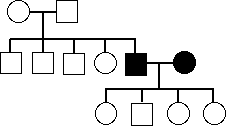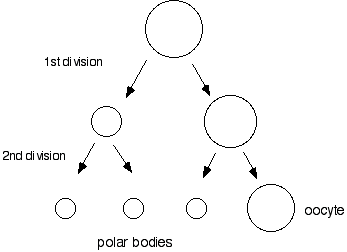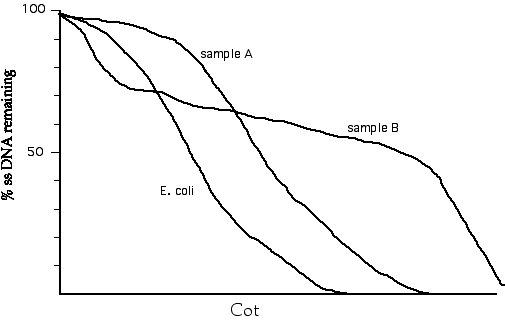
a) This pedigree is consistent with autosomal dominant inheritance.

b) This pedigree is consistent with X-linked recessive inheritance.

c) Mendelís principle of segregation states that genes on different chromosomes may separate during the production of gametes.
d) A test cross is a mating between an individual of unknown genotype with a homozygous dominant individual.
e) Grasshoppers have an X0 sex determination mechanism. This means that males are the heterogametic sex.
f) The LOD score method can be used to test for recombination.
2) 22 pts. Short Answer section: Answer the following questions and provide a short explanation.
a) Is it possible for a single allele to be both dominant and
recessive? If yes, explain or give a supporting example, if no, explain
why not.
b) A couple, neither of whom has phenylketonuria (an autosomal recessive
trait), have a child with PKU as their first child. They plan to have three
more children. What is the likelihood that at least one of these additional
kids will have PKU?
c) About one person in 70 is heterozygous for albinism. A normal woman
whose parents were normal but who has an albino brother marries an unrelated
normal man. What is the probability that if they have a child it will be
an albino? Would the probability be larger if the woman marries her cousin?
d) Offer an explanation for the following pedigree if: i) one gene is involved, or ii) more than one gene is involved.

e) Many RNA viruses contain either double-stranded RNA genomes or produce ds RNA molecules during replication. One cellular enzyme that may be involved in antiviral defense is adenosine deaminase. Adenosine deaminase modifies adenine bases in dsRNA converting them into inosine which has the pairing properties of guanine. Briefly speculate on why this enzyme activity could provide protection against RNA viruses.
3) 18 pts. Recall the meiotic process that generates an egg.

Turkey eggs sometimes develop without fertilization (parthenogenesis). There are three plausible mechanisms: (a) the egg could simply fail to enter meiosis, remaining diploid; (b) the egg nucleus could be fertilized by a polar body; (c) the chromosomes of a haploid nucleus could double.
Predict the sex ratio in the progeny for each of the three hypotheses. (Remember, in birds the female is the heterogametic sex, where the Z chromosome is analogous to the mammalian X, and the W analogous to the Y.)
| Cross |
|
|
|
| A | green X gray | all green | 3/4 green:1/4 gray |
| B | green X brown | all green | 3/4 green:1/4 brown |
| C | gray X brown | all green | 9/16 green; 3/16 brown; 3/ 16 gray; 1/16 blue |
a) How many genes are involved? Define gene symbols and indicate which
genotypes yield each phenotype.
b) In a cross between a gray eyed cat and one of unknown genotype
and phenotype the F1 generation was not observed. However, the F2 resulted
in the same F2 ratio as cross C. Determine the genotypes and phenotypes
of the unknown P1 and F1 cats.
5) 12 pts. Consider the following DNA replication intermediate in E. coli.

a) Label the strands 5í and 3í.
b) With regards to the enzymes and activities listed below, which ones have completed their roles in DNA replication? Which have not? Briefly explain your answers.
DNA polymerase I
5í-3í exonuclease
3í-5í exonuclease
5í-3 polymerase
DNA polymerase III
3í-5í exonuclease
5í-3í polymerase
DNA ligase
DNA primase
DNA helicase
Single stranded binding protein (SSB)
6) 18 pts. The mutation SxlM1 is a male-specific X-linked lethal allele that kills males without effecting females. The Sxl gene maps immediately adjacent to carmine eyes (cm) at 20.0 cM. Recently a female-specific recessive lethal that also maps on the X (flex1 ófemale lethal on X) was reported to partially suppress the male-lethal phenotype of SxlM1. That is, males of genotype SxlM1 flex1/ Y sometimes survive, whereas SxlM1/ Y males always die. On its own, flex1 has no phenotype in males. The flex gene maps at 54.0 cM. To assess the ability of flex1 to rescue SxlM1 males the following cross was done:
cm SxlM1 + / + + flex1 ™™ X ¢¢ +++ /Y
The following progeny were recovered:
Females 2028
Males 987 cm+
95 cm
a) Using the information provided, estimate the efficiency with which the flex1 mutation rescues the SxlM1 male-lethal effect. Show your work.
b) What was the purpose of cm in this experiment?
c) The flex allele is a suppressor of the SxlM1 mutation. Does flex exhibit variable penetrance or variable expressivity with respect to its ability to rescue SxlM1? Explain.
Extra credit 4 pts
EC) Compare the following Cot curves representing DNA rehybridization kinetics. What can be said about the two unknown DNAs with respect to E. coli DNA?
